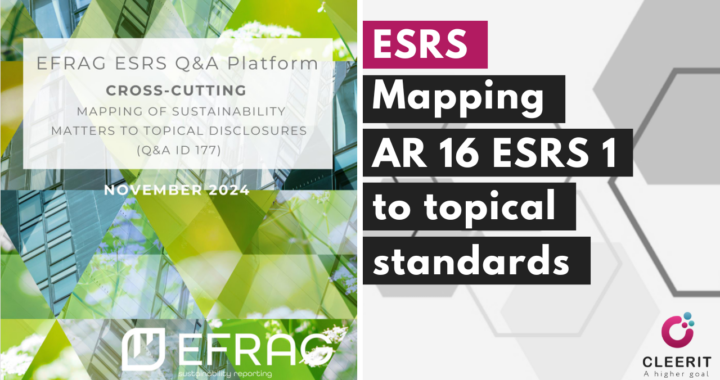EFRAG Q&A compilation November 2024, page 103 – Question ID 935
EFRAG has released an answer to our question (ID 935) regarding how to distinguish current versus anticipated financial effects to be published in ESRS 2 SBM-3 paragraph 48 datapoints (e) and (d).
Thank you EFRAG for taking the time to provide this clarification.
ESRS 2 SBM-3 specifies that
- the undertaking may omit the information prescribed by paragraph 48 (e) – anticipated financial effects – for the first year of preparation of its sustainability statement,
- but not the information regarding the current financial effects, in paragraph 48 (d), linked to a significant risk of a material adjustment within the next annual reporting period.
Annex II Acronyms and Glossary of Terms defines:
- ‘current financial effects’ as ‘Financial effects for the current reporting period that are recognised in the primary financial statements’; and
- ‘anticipated financial effects’ as ‘Financial effects that do not meet the recognition criteria for inclusion in the financial statement line items in the reporting period and that are not captured by the current financial effects’.
In other words, the current financial effect has already been recognised at or before the reporting date, whereas the anticipated effect might occur thereafter, be it in the short (within the reporting period, after the balance-sheet date), medium- or long-term.
For example, an impairment charge recognised in the current reporting period in accordance with IAS 36 Impairment of assets is a current financial effect whereas a disclosure in accordance with IAS 36 paragraph 134 (f), requiring the disclosure of a potential impairment based on a ‘reasonable possible change in key assumptions’, is an anticipated financial effect.
According to ESRS 2, the paragraph 48 (d) requires the disclosure of:
- the current financial effects of the undertaking’s material risks and opportunities on its financial position, financial performance and cash flows and the material risks and opportunities
- for which there is a significant risk of a material adjustment within the next annual reporting period to the carrying amounts of assets and liabilities reported in the related financial statements
EFRAG answers that
“This datapoint [48.d] does not qualify as current financial effects, but as anticipated financial effects for which there is a significant risk of a material adjustment within the next annual reporting period.
In this sense, there is an overlap, as the datapoint ‘adjustment within the next annual reporting period’ is also part of the anticipated financial effects to be reported under ESRS 2 paragraph 48 (e).
The undertaking may incorporate disclosures using cross-references to the respective parts in the financial statements to avoid repetitions.”
Our understanding of this answer is that the datapoint 48 (d) should also read “anticipated” financial effects, and not “current” financial effects.
And, as such, the undertaking may omit also this information for the first year of preparation of its sustainability statement.
Source (ID 935, page 103): https://www.efrag.org/sites/default/files/media/document/2024-12/Explanations%20January%20-%20November%202024.pdf

